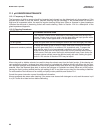
44
MODEL 6081-P pH/ORP SECTION 11.0
MAINTENANCE
11.3 pH SENSOR MAINTENANCE
11.3.1 Frequency of Cleaning
The frequency at which a sensor should be inspected and cleaned can be determined only by experience. If the
process liquid coats or fouls the sensor, frequent cleaning may be necessary. If the process does not contain a
high level of suspended solids, the need for regular cleaning will be less. Often an increase in glass impedance
indicates the electrode is becoming fouled and needs cleaning. Refer to Section 12.4 for a description of the
glass impedance diagnostic.
11.3.2 Cleaning Procedures
When using acid or alkaline solvents, be careful to keep the solvent away from the liquid junction. If the cleaning sol-
vent contacts the junction, hydrogen ions (acid solvent) or hydroxide ions (alkaline solvent) will diffuse into the junc-
tion. Because hydrogen and hydroxide ions have much greater mobility than other ions, they produce a large junction
potential. When the electrode goes back in service, the hydrogen or hydroxide ions slowly diffuse out of the junction,
causing the liquid junction potential and the pH reading to drift. It may take hours or days for the reading to stabilize.
For a discussion of the influence of ion mobility on liquid junction potentials, see Section 13.4.
Consult the sensor instruction manual for additional information.
Always recalibrate the sensor after cleaning. If the sensor was cleaned with detergent or acid, soak the sensor in pH
4 or pH 7 buffer for at least an hour before calibrating.
PROBLEM
CLEANING SUGGESTIONS
Loose scale or debris
Use a stream of water from a wash bottle to rinse away solids from the tip of the
sensor. If water does not work, gently wipe the glass bulb and liquid junction with a
soft cloth, tissue, cotton-tipped swab, or a soft bristle brush.
Oil and grease Wash the glass bulb with mild detergent solution and rinse thoroughly with water.
Hard scale (carbonate sulfate
scales and corrosion products)
If wiping the sensor tip with a tissue or cotton swab does not remove the scale,
soak the glass bulb ONLY in a solution of 5% hydrochloric acid. To prepare the
acid solution, add 15 mL of concentrated hydrochloric acid to 85 mL of water.
Keep the acid away from the liquid junction and from any stainless steel portions
of the sensor. Rinse the sensor thoroughly with deionized water. Some scales (for
example, calcium sulfate) cannot be removed easily with acid. Soaking the glass
bulb in a 2% solution of disodium EDTA may be helpful.


















